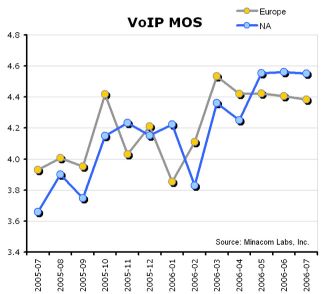Minacom, VoIP service quality increased steadily over the last year
 Test Results from over 14,000 test calls placed by Minacom’s PowerProbe 6000
Test Results from over 14,000 test calls placed by Minacom’s PowerProbe 6000
to Western European and North American destinations from July 2005 to July 2006
Montreal, Canada (Monday, August 28th, 2006) — VoIP phone service now sounds better and connects faster than the standard public-switched phone network (PSTN), according to data collected over the last 12 months by Minacom’s standards-based, single-ended service quality test system. Results show that VoIP service quality increased steadily over the last year, with an average Mean Opinion Score (MOS) of 4.2, compared to 3.9 for the PSTN - MOS is a scale commonly used to describe speech quality, ranging from 1 (worst) to 5 (best). Based on a MOS threshold of 3.6, only 1 out of 50 calls in North America were considered to be unacceptable - 1 in 10 worldwide - while greater than 85% of VoIP calls exceeded average PSTN quality over the same period. Detailed results show that VoIP service bettered PSTN quality worldwide, and improved in all regions over the course of the survey. In addition to superior sound quality, calls over VoIP connected quicker overall - 8.2 seconds on average, compared to 8.9 seconds for those placed over the PSTN. Regionally, the PSTN was faster to connect for calls placed to North America (4.3 seconds vs. 5.7 for VoIP), while international calls connected faster with VoIP (8.7 vs. 10.4 seconds for PSTN). Linear regression indicates that VoIP is closing the gap, connecting 2 seconds faster in July 2006 than a year earlier.
A recent Internet Phone quality study by Brix Networks indicated that 1 in 5 calls were classified as unacceptable, and that call quality was steadily declining. As this study may have created the impression that VoIP service is not capable of delivering PSTN-grade phone service, Minacom felt it should be clarified for both those in the VoIP industry, and individuals and enterprises considering VoIP service, that this report evaluated computer-to-computer (PC-PC) Internet phone service, similar to those offered by Skype™, Google™ Talk, MSN™ and Yahoo™ Messenger. The quality and service reliability of these applications does not compare to that of the VoIP phone services offered by telcos, cable operators, and broadband VoIP providers who carefully deploy, monitor and manage the quality of their services. PC-PC VoIP quality is subject to many diverse impairments, including firewall settings, computer performance, antivirus installations, high-compression codecs, and Internet bandwidth shared with gaming, file downloads, web surfing and email. By contrast, VoIP offered by service providers is switched using telecom grade equipment, uses lower-compression codecs, and is prioritized over regular Internet traffic using sophisticated, standards-based multimedia telephone adapters (MTAs), maintained and monitored by the operator.
Minacom’s tests were conducted over PSTN, managed broadband and cable VoIP lines, the same services offered to residential and enterprise customers by phone, cable and hosted VoIP providers. Each month, Minacom’s PowerProbe® 6000 service level test probe places hundreds of calls from Minacom’s QoS labs in Montreal, Canada, to public destinations worldwide over PSTN, broadband VoIP, cable VoIP, DSL, FTTP and wireless networks, publishing the results in the Minacom QoS Benchmark Reports, a free email newsletter now in its fourth year of circulation. The results shown in this current study are based on the data published in these reports over a one year period from July 2005 to July 2006. Minacom’s QoS Benchmark Reports are used by the ITU Quality of Service Development Group in studies summarizing global phone quality, published annually to carriers worldwide for the consistency and accuracy of the measurements reported. Minacom’s Public Termination Inventory (PTI) database, used by the DirectQuality® R7 web-based test-OSS to automate the calls, contains over 200,000 far-end public numbers in 230 countries and administrative regions worldwide.
The human ear is an analog device, and sound is an analog signal, so it is important to include analog signal analysis when evaluating speech quality. Minacom’s DirectQuality R7 test system uses an award-winning combination of ITU and industry standard algorithms to calculate listening quality MOS using both analog and IP measurements. MOS scores based only on IP packet statistics do not capture the effects of echo cancellers in network equipment and telephone adapters, noise introduced by copper wiring, or issues with call volume and delay. Minacom’s PowerProbe 6000 IVR Test Agent measures a wide range of analog and IP impairments, including noise, echo, delay, packet loss, call volume, jitter and loss, as well as a complete array of connectivity metrics including Post Dial Delay (PDD), Answer Seizure Ratio (ASR), and Dial-Tone Delay (DTD). Minacom’s single-ended testing technology is used by multi-billion minute/year carriers worldwide to perform automated least-cost routing, validate partner carriers, monitor VoIP service quality and assure IP Peering SLAs.
“Carriers are becoming increasingly educated about MOS scoring and want to know where MOS scores are coming from.” commented Frost and Sullivan Telecom Industry Manager & Analyst, Jessy Cavazos, adding, “There are numerous products in the market that only look at the packet metrics. Hence, many carriers are starting to see degradation they should not see, or not seeing degradation they should see. False service quality alarms result in unproductive troubleshooting efforts by service providers, whereas unidentified quality issues ultimately leads to dissatisfied customers. That is why Minacom uses three different technology sources for MOS scoring instead of only one, so as to capture all possible service issues with the highest degree of accuracy available."
Press release

0 comments:
Post a Comment